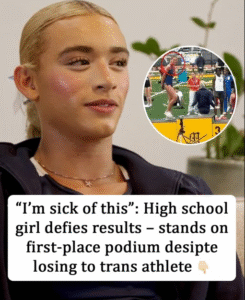High School Girl Claims First-Place Podium Spot Despite Losing to Trans Athlete
At a recent high school track and field event in California, a powerful moment unfolded that quickly drew national attention. During the CIF Southern Section Finals, a transgender athlete named AB Hernandez from Jurupa Valley High School placed first in both the girls’ triple jump and long jump events. Hernandez’s performance secured official first-place victories according to state rules, which allow athletes to compete in alignment with their gender identity.
However, after placing second in the triple jump event, 17-year-old Reese Hogan from Cream Lutheran High School took a bold and symbolic stand. As the athletes gathered for the podium ceremony, Hernandez stepped aside, and Hogan briefly stood on the first-place podium. The moment was met with cheers and applause from spectators, some of whom saw the gesture as a protest against what they believe to be an unfair playing field in girls’ sports.
Photos of Hogan on the top podium quickly went viral, with many supporters, including outspoken women’s sports advocate Riley Gaines, calling her the “real champion.” Supporters argue that biological differences between male and female athletes create an unfair advantage in female competition, and Hogan’s act was praised as a demonstration of courage and defiance.
Opponents of transgender inclusion in female sports have pointed to incidents like this as evidence of a growing controversy. They argue that while inclusivity is important, it should not come at the cost of fairness for cisgender girls and women who train under the assumption of equal competition.
On the other side of the debate, advocates for transgender athletes stress that these students face significant challenges, discrimination, and scrutiny. Hernandez, despite the public attention, has not commented directly on the podium moment, but has been defended by civil rights groups and some educators who insist that transgender students deserve the same opportunities as any other athlete.
This event also comes amid a national conversation about transgender athletes and school sports policies. While some states have passed laws banning transgender girls from participating in female sports, California has taken a more inclusive approach. The California Interscholastic Federation allows student-athletes to compete in accordance with their gender identity, which has sparked both support and backlash.
The moment with Hogan and Hernandez highlights the ongoing tension in American high school sports between inclusion and perceived fairness. Though the rules determined the official placements, Hogan’s decision to pose as the first-place winner resonated with many who feel current policies need to be reconsidered.
As this debate continues to unfold across courts, school boards, and political platforms, young athletes like Hogan and Hernandez are at the center of a cultural crossroads—one that challenges long-held ideas about gender, fairness, and the meaning of competition.


